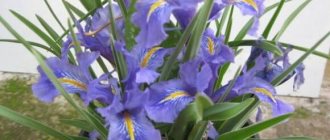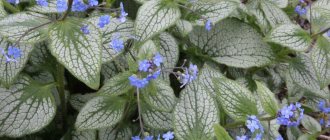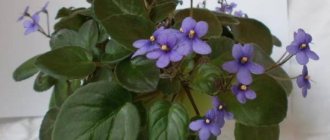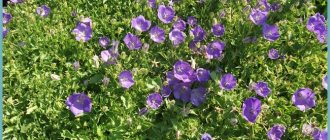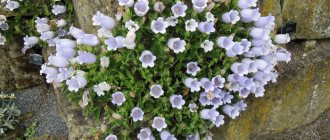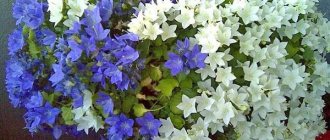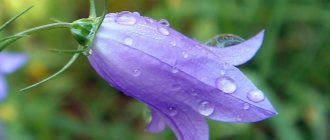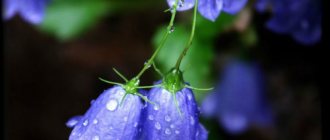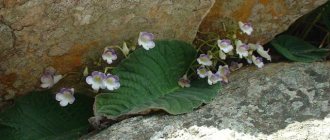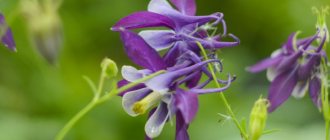Aquilegia is a flower that is popularly called elf's slipper, columbine, eagle or dove, and is often mentioned in myths and fairy tales. Such unusual names were assigned to the plant due to the originality of the flower shape. Truly unusual, unlike anything else, aquilegia flowers will decorate gardens located in the northern hemisphere. In other parts of the world, decoratively bred hybrid varieties are used for landscape design.
Aquilegia, most often called columbine, is a herbaceous perennial from the ranunculaceae family. The main habitat is the mountainous regions of the northern regions.
catchment area
Description of the plant
The original perennial columbine flower, which has not been subjected to selection, is a low plant, reaching 30 cm during the growing season. But during flowering, under favorable weather conditions, it can grow up to 1 m. Moreover, the stems can fall to the ground.
In most cases, the flower lives for 2 years. In the first year of its development, it forms a bud for a flowering shoot, which is thrown out at the beginning of summer. By autumn, a small rosette of leaves forms, dying and overwintering. In the second year, last year's leaves are replaced with new ones.
Aquilegia in a flowerbed
Single flowering - one drooping flower is formed on a flexible flowering stem. The description of the plant would be incomplete without mentioning that the petals of an alpine flower can have a variety of colors - white, red, yellow, crimson, blue, as well as a combination of several colors.
The corolla is 5 petals, located separately from each other. They form a kind of funnel, in which a wide hole is cut obliquely. It is noteworthy that in addition to the main petals, the flower has spurs. They are longer and narrower, curved towards the stem.
Important ! It is the length of these spurs, as well as the intensity of their twisting, that scientists use to classify aquilegia.
Some varieties of aquilegia form panicles of flowers, unlike the single flowering plant that grows in the wild.
After flowering, the aquilegia fruit is formed. It is a multileaf (pod-like fruit) with black shiny seeds.
Note! The seeds of the plant are poisonous and retain intensive germination for 1 year.
Aquilegia: planting and care in open ground
Aquilegia - growing from seeds
It must be borne in mind that common aquilegia blooms for 2 years. Flowers are produced intensively from early June to early August.
Aquilegia has become quite often used in the design of flower beds and lawns. If you choose the right height of the plant, you can use it to decorate landscape alpine slides. It is most suitable for mixing with other plants. After all, its natural distribution area is mountainous regions. Therefore, you just need to pay attention to your companion plants - and the result will surprise and delight even the most demanding aesthetes.
As for tall plants, they look better when planted closely in one place. You should not plant aquilegia in a row, as tall representatives of this genus can simply overwhelm the flower stalks from strong winds or heavy rainfall.
Tall aquilegia in combination with other flowers
The main thing is to choose the right variety and then flowers of a certain color, shape and size will be able to decorate any flower bed. In particular, you need to pay attention to the height of the peduncle so that it does not drown out its neighbors and does not get lost among them.
Reproduction
You can get new aquilegia bushes:
- growing seedlings from seeds;
- cuttings;
- dividing an adult bush.
How long does aquilegia bloom?
Monstera flower - what the plant and leaf look like
Under favorable conditions, a suitable amount of sunlight, and the proper level of humidity, this plant is able to delight the eye with its delicate and sophisticated flowers almost throughout the entire summer.
Note! But it is worth remembering that the hotter it is and the more sunlight, the smaller the flowers become, and the flowering period is significantly reduced.
If you want your aquilegia to produce intense flowering, then you should take care of planting and caring for it in open ground according to the following rules:
- It is better to choose partial shade. Otherwise, in strongly illuminated areas, the flowers will be smaller in size, and the flowering period may be reduced to 1 month;
- the soil should be moderately moist. To do this, it is necessary to water the plants as the top layer of soil dries. It is also worth taking care of timely loosening - this will ensure the necessary flow of oxygen into the soil. In order for the soil to become light, as aquilegia loves, it is necessary to add humus to it. Feeding is carried out with standard mineral supplements suitable for flowering plants.
Aquilegia Terry
Aquilegia Terry is an unusual variety of plant, which is distinguished by its largest flowers, reaching a diameter of 10 cm. It was bred artificially in order to diversify the flowers and achieve a certain effect.
A distinctive feature is its multi-petal structure. The flower itself is formed from narrow petals arranged in several rows. When it comes to coloration, the intensity of the color decreases as it approaches the center. Shades can range from white to lilac.
The leaves of this plant variety have a specific bluish coating.
Note! When breeding Aquilegia Takhrova, breeders managed to achieve higher frost resistance. This makes it possible to grow a plant of this variety in regions more northern than its natural distribution area.
This is what ensured the great popularity of the variety among gardeners.
Aquilegia Terry
Aquilegia Hybrid
The name itself indicates that breeders have worked to improve both the shape and size of the flower, and the versatility of its color. Breeders managed to achieve such results by crossing the watershed of an Alpine and an American plant variety.
Aquilegia hybrid is distinguished by its tall growth - shoots can reach 1 m in height. And the flowers themselves are quite large - up to 10 cm in diameter. If we talk about the number of flower petals of this variety, they can be standard - 5 main ones and 5 spurs. In other variations of the variety, the number of petals can be significantly greater and thus form a double or fan-shaped flower.
The most common color options are a combination of white with blue or red. Monochromatic coloring of the peduncle is also common.
Important ! If you want to get an abundant flowering cap on your flowerbed or lawn, then you should choose hybrid aquilegia, as they are distinguished by abundant simultaneous flowering, which lasts quite a long time.
This variety is also suitable for growing in more northern regions than it usually grows - it is quite frost-resistant and unpretentious in care.
Aquilegia Hybrid
Popular varieties
Many varieties have been developed that vary in bush height, flower size and color, spur length, and doubleness.
Tall (above 60 cm)
- Hybrid aquilegia (A. x hybrida) - large flowers of all colors;
- Hybrids are the tallest (up to 120 cm) aquilegias with large upward-facing flowers of all colors;
- Aquilegia sticky (A. glandulosa) - lilac-blue flowers;
- aquilegia (A. vulgaris) - purple flowers with a short spur;
- Aquilegia olympica (A. olympica) - drooping white-blue flowers.
Aquilegia olympica @doganinsirdaslari, Instagram
Aquilegia McKana @bipbop_garden, Instagram
Aquilegia hybride 'Nora Barlow' @aavikutaluaed, Instagram
Aquilegia glandulosa @efc1464, Instagram
Low (height 10-30 cm)
- Aquilegia (A. alpina) - purple flowers with a short spur;
- Aquilegia fan-shaped (A. flabellata) - large blue flowers with a pale yellow edge without spurs;
- aquilegia (A. caerulea) - blue and white flowers, thin spurs;
- Canadian aquilegia (A. canadensis) with red and yellow flowers.
The last two species are rock plants of North America.
Aquilegia alpina @lifeinflower, Instagram
Aquilegia flabellata @dream_taru, Instagram
Aquilegia caerulea @valleyviewgardens, Instagram
Aquilegia canadensis @soiledplantiez, Instagram
Aquilegia vulgaris
The usual distribution area of this flower is in the European part of the Eurasian continent.
It differs in height, ranging from 30 to 70 cm - depending on the conditions that exist in a certain region or season.
The main part of the leaves of the variety are located at the base of the petiole and leaves are much less common along the length of the stem. They are double trifoliate, with a slight bluish coating.
Note! Flowers of this variety are distinguished by the fact that they have a small variety of petal colors. Most often these are blue, purple and pink shades.
If we talk about the size of the peduncle, then it is quite average in size. Only 4, maximum 5 cm in diameter. As for the number of petals, they can be standard and include 5 main and 5 spurs. Other variations include double flowers.
Important ! This variety can withstand frosts that last quite long and with temperatures down to -35°C. Therefore, it can be planted even in regions where winter temperatures are quite extreme or in areas that are high above sea level.
It is all of the above characteristics of this variety of aquilegia that make growing and caring for it quite easy.
Aquilegia vulgaris
What to do after flowering?
Immediately after flowering of the aquilegia, ineffective stems must be cut off to the very root. Those that are healthy can be used to prepare compost, and the infected ones can be disposed of - under no circumstances leave them on the site, much less near the plants!
If you plan to collect seeds for subsequent planting, leave the flower stalks of the bushes that you want to propagate and wait until they are completely ripe. Small seeds tend to fall off, so it is better to put a small bag of cotton fabric on the peduncle.
Aquilegia Winky
It is most often used to decorate the garden in landscape design, for interiors (as balcony flowers) or as a potted flower.
A distinctive feature of Aquilegia Vinki is a fairly compact bush, reaching a height of no more than 20-30 cm.
At the end of the stem, 20 cm long, there is one flower, which most often is a double combination of petals complemented by spurs. Coloring varies from single-color petal options to a combination of several shades.
Such aquilegia at the dacha allows you to quite effectively decorate not only flower beds, but also the facade of the building, as designers suggest planting it in hanging pots.
Aquilegia Winky
Decorative qualities
As you can see from the photo of flowers, aquilegia is an excellent option for creating landscape design. It goes well with conifers, such as European spruce and Korean fir, creating a contrasting and light Mediterranean style. The catchment area looks good near a decorative pond against the background of various coastal plants.
Aquilegia is also used on alpine slides, rock gardens, and flower beds. True, varieties should be carefully selected for them, taking into account the spreading nature and height of the bush, as well as the shade and time of blooming of the buds.
On average, flowering lasts about a month. With good care it can increase to 7 weeks.
Aquilegia is famous not only for the beauty of its flowers, but also for the decorativeness of its foliage. By choosing the right varieties, you can change the design of your site and give it sophistication and tenderness.
Aquilegia Yellow
Another perennial plant hybrid is the Yellow Aquilegia variety. Its distinctive feature is golden flowers of a single color, which have a fairly standard shape, characteristic of a wild-growing catchment. This species is popular in North America, but recently it has become increasingly in demand among domestic gardeners. This is due to the fact that bright flowers of a rich yellow hue begin to bloom quite early and continue to send out flower stalks abundantly throughout the summer.
As for growing regions, it feels best in regions with a temperate continental climate.
Aquilegia Yellow
Origin of the flower
The perennial herbaceous plant belongs to the large Ranunculaceae family. The genus includes up to 120 plant species with similar characteristics. Most of them grow in the mountains and inhabit the northern part of the globe. Up to 35 species are cultivated by people.
Aquilegia is a Latin name. Its origin is unknown for certain. If we divide the name into two independent words, then the last “legere” in translation means “to collect.” The first part is more difficult. There are 2 interpretations here: aqua - water and aquila - eagle. This is where the popular names “catchment” and “orlik” came from.
Why Aquilegia is called Colombian is also unknown. A similar name is common in England. Shakespeare mentions the columbine flower in Hamlet. Ophelia offered this wonderful creation to Laertes.
Important! Medieval artists depicted the presence of the Holy Spirit in the picture with the image of aquilegia.
Aquilegia Columbine
This is a perennial with a compact but fairly tall bush - up to approximately 70 cm. The variety is cold-hardy, which makes it, like Aquilegia Ordinary, a suitable species for growing in the Siberian regions.
A distinctive feature of Aquilegia Columbina is its more elongated flower shape, reminiscent of a bell-shaped bowl. The shades of the petals can vary from the lightest (white) to deep dark purple.
Aquilegia Columbine
Use in landscape design
When working with aquilegia, your imagination is not limited by anything, because it can be used in any form. It can be planted both in open ground and in flowerpots.
Tall varieties combine well with irises, bells, lupins, hostas and many other plants. Low-growing species fit perfectly into rock gardens, rock gardens, ridges and harmonize with cereals, sedums and saxifrages.
Also, thanks to the variety of shades of flowers, you can create multi-colored flower beds that look very picturesque.
Aquilegia White
White varieties of catchment look quite impressive. They can become a real decoration of the garden, especially in combination with other flowers of brighter colors.
There are several varieties of White Aquilegia, such as “Snow Queen”, “Tower white”, “White Star”.
Note! Each variety has a fairly long flowering period. Some of them can be planted in Siberia or the Urals due to their fairly efficient growth and frost resistance.
If we talk in general about how to care for this type of aquilegia, then it is as unpretentious as all the others. The main thing is to choose the right time to sow seeds or plant seedlings. And also ensure suitable conditions for humidity and soil quality
Pest and disease control
This crop very often becomes a “victim” of attacks by harmful insects. During the hot season, it can become infected with spider mites or aphids. Pests quickly multiply on thin, tender leaves and can destroy the bush. If aquilegia is planted on airtight, heavy soil, and water often stagnates in the root hole, the likelihood of gray rot increases. It is necessary to inspect the bushes from time to time, and if problems arise, use insecticides, for example, Aktelik.
Aquilegia alpine
The Alpine Aquilegia variety is a small plant. It rarely reaches a height of more than 40 cm. However, if you artificially create the most comfortable conditions for growth and regularly feed it, you can grow flower stalks up to 80 cm high. However, most often the plant is quite short.
Peak flowering for this variety occurs at the beginning of June, end of July. The flower is ordinary in shape. Unpretentious to conditions.
But still, aquilegia will require specific care after flowering. In order to rejuvenate the bush, it must be replanted before it is 2 years old. Otherwise, you can damage the root system of the flower. It is also important to rejuvenate the plant to maintain an attractive appearance. This can be done by cutting down the faded peduncle.
Important ! After seven years of age, the plant withers. It stops giving color, the leaves become small and inconspicuous. Therefore, a radical rejuvenation of old bushes is required by planting new flowers. Varieties that are annuals need to be planted annually.
To summarize all of the above, it is worth noting that in landscape design, Aquilegia Columbian, Biedermeier, Hybrid, Clementine and Terry are the most popular. These are ideal plants for mixborders and alpine lawns. Due to their unpretentiousness, they easily take root and do not require intensive care or frequent fertilizing. But, it is still desirable that the plant be provided with partial shade - this way the flowers achieve the most attractive appearance and large size. In this case, it is also possible to achieve longer flowering.
